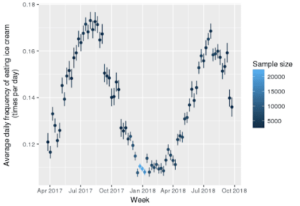By Briana Cameron, Ph.D., 23andMe Scientist, Biostatistics
As the year comes to an end and the temperature starts to drop, your urge for frosty treats like ice cream may also wane. At least, that’s what data from 23andMe research participants shows us:

Customers were asked to report on how frequently they had consumed ice cream in the past month, with options ranging from never to two or more times a day. If we look at the week in which a customer answers this question, we can see that, unsurprisingly, customers tend to eat more ice cream in the summer months. Ice cream consumption reaches a low point in January.
Evaluating these seasonal patterns, and adjusting for these trends in analyses of nutrition data, allows for more accurate research in this field.
Eating Habits
Diet is an important component in studying many health outcomes, and a more nuanced consideration of how season affects our eating habits may provide researchers with a better understanding of the connection between diet and our health. In addition, understanding how factors such as food availability and cultural influences, which may be tied to season, impact what we eat may help inform policies and programs designed to improve diet quality.
 Not all foods follow the seasonal pattern observed in ice cream consumption, however.
Not all foods follow the seasonal pattern observed in ice cream consumption, however.
In fact, when looking at the consumption of chocolate and other candy, the pattern reverses: Candy consumption reaches a peak in the winter, with slightly less candy consumption in the summer months. We can also see an increased candy intake right around Halloween, illustrating the power of this survey to detect these small perturbations in typical dietary intake.

The plot above shows the mean and standard error bars for the average number of times a day a customer reports eating chocolate or other candy for each week during the year.
Halloween and other holidays can have strong, sharp impacts on our diet, but other factors may be involved as well. Certain foods, such as fresh fruit and vegetables, may be less readily available during the winter in certain places, which may impact consumption of those foods. In addition, cultural associations may influence how people eat throughout the year; for example, ice cream is often seen as a summer treat, and soup may be thought of as a good meal on a cold winter day.
The 23andMe research model, which is based on a continuous collection of self-reported data over a long period of time, allows for more detailed investigation of behavioral patterns and dietary habits over time. It will be important to understand and adjust for variables related to season, such as the time a customer takes a survey, in order to form a more clear picture of the role of nutrition in leading a healthy life.




